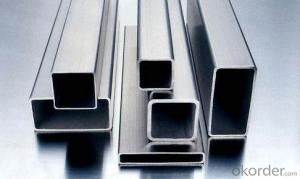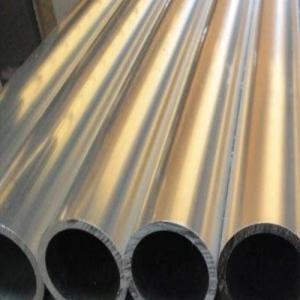Aluminium Square Pipe-AA 6082
- Loading Port:
- China Main Port
- Payment Terms:
- TT OR LC
- Min Order Qty:
- -
- Supply Capability:
- -
OKorder Service Pledge
OKorder Financial Service
You Might Also Like
Aluminum alloy | 6063,6061,6005,6082,7075,1050etc |
Temper | T3-T8 |
shape | square, round, flat, angle ,etc |
surface | Anodizing ,Powder coating, Electrophoresis, etc |
Deep processing ability | Drill hole ,stretch bending, milling, welding, fabrication, etc |
Usage | Windows & door , LED panel, heat sink , curtain wall , solar Panel Frame, rail & fence , ladder ,etc. |
MOQ | 1Ton |
Packing | According to your requirement ,such as shrink wrap, plastic bag, kraft paper ,etc. |
Delivery | 15-20days after sample confirmed & down payment. |
Loading port | Quanzhou, Xiamen |
Shipping term | EXW,FOB,CFR,CIF |
Payment term | T/T,30% advanced deposit, the balance paid off before loading, or consulting |
Moulds | 1,Using our moulds ,no fee |
2,Using customer drawing, opening mould, usually over 4tons then the moulds fee can be refunded | |
3,Mould cost is negotiable base on the order quantity |
- Q: Maintenance personnel, Hisense inverter air conditioning with copper or aluminum tube?
- Some Hisense air-conditioning factory is indeed used for aluminum tubes, dedicatedI hope my answer is helpful to you. Welcome to accept it as encouragement. I wish you happiness!
- Q: Are aluminum pipes suitable for underground drainage systems?
- Yes, aluminum pipes can be suitable for underground drainage systems. Aluminum is a lightweight and durable material that is highly resistant to corrosion, making it a good option for underground applications where it may come into contact with moisture and other elements. Additionally, aluminum pipes have a long lifespan and require minimal maintenance, making them a cost-effective choice for drainage systems. However, it is important to consider the specific requirements of the drainage system and consult with experts to ensure that aluminum pipes are the most suitable option for the specific project.
- Q: What are the different pressure ratings available for aluminum pipes?
- The pressure ratings for aluminum pipes can vary depending on the specific type and size of the pipe. However, commonly available pressure ratings for aluminum pipes range from 150 psi (pounds per square inch) to 300 psi.
- Q: Do aluminum pipes require any special coatings?
- Aluminum pipes often necessitate special coatings to safeguard them against corrosion and other potential harm. Although aluminum is a lightweight and durable substance, it is susceptible to corrosion when exposed to specific substances and elements. To avert this, aluminum pipes are frequently treated with various protective substances like epoxy, polyurethane, or powder coatings. These coatings form a barrier between the aluminum surface and the surroundings, effectively preventing corrosion and prolonging the pipes' lifespan. In addition, specialized coatings can also augment the thermal resistance, UV resistance, and visual appeal of aluminum pipes, rendering them suitable for a broad range of applications in industries such as construction, automotive, and aerospace.
- Q: Can aluminum pipes be painted or coated?
- Aluminum pipes have the capability of being painted or coated. Aluminum, being a versatile material, can easily be painted or coated to improve its appearance or provide extra protection. To ensure good adhesion of the paint or coating, it is vital to adequately prepare the surface by cleaning and degreasing it. It is also advisable to use a primer specifically designed for aluminum surfaces, as it enhances adhesion and durability. The selection of paint or coating depends on the desired outcome and the specific application of the aluminum pipes. For instance, for exterior use, it is crucial to opt for a paint or coating that is resistant to UV rays and weathering. Overall, by properly preparing the surface and using suitable paints or coatings, aluminum pipes can be effectively customized to meet various requirements.
- Q: What are the advantages of using aluminum pipes over other materials?
- There are several advantages of using aluminum pipes over other materials. Firstly, aluminum pipes are known for their lightweight nature. Compared to other materials such as steel or copper, aluminum pipes are significantly lighter, making them easier to handle and transport. This makes them a preferred choice in various industries, especially for applications where weight reduction is important, such as aerospace and automotive industries. Secondly, aluminum pipes have excellent corrosion resistance. Aluminum naturally forms a protective oxide layer on its surface, which helps prevent rust and corrosion. This makes aluminum pipes suitable for use in environments that are exposed to moisture, chemicals, or extreme weather conditions. Additionally, their resistance to corrosion ensures a longer lifespan and reduces the need for frequent maintenance and replacements. Furthermore, aluminum pipes possess high thermal conductivity. They are able to efficiently transfer heat, making them ideal for applications that require heat exchange or thermal management. This characteristic is particularly beneficial in industries like HVAC, refrigeration, and automotive cooling systems, where heat dissipation is critical. Another advantage of aluminum pipes is their versatility. Aluminum is a highly malleable material, allowing it to be easily formed into various shapes and sizes. This flexibility makes aluminum pipes suitable for a wide range of applications, from plumbing and irrigation systems to structural frameworks and electrical conduits. Lastly, aluminum pipes are environmentally friendly. Aluminum is a highly recyclable material, and the recycling process requires only a fraction of the energy compared to the initial production. By using aluminum pipes, companies can contribute to sustainability efforts by reducing their carbon footprint and minimizing waste. In summary, the advantages of using aluminum pipes over other materials include their lightweight nature, excellent corrosion resistance, high thermal conductivity, versatility, and environmental friendliness. These characteristics make aluminum pipes a preferred choice in many industries, providing numerous benefits in terms of efficiency, durability, and sustainability.
- Q: Can aluminum pipes be used in HVAC systems?
- Yes, aluminum pipes can be used in HVAC systems. Aluminum is a popular choice for HVAC systems due to its excellent thermal conductivity, corrosion resistance, and lightweight nature. It is commonly used for refrigerant lines, air distribution, and heat transfer applications in HVAC systems.
- Q: Can aluminum pipes be threaded?
- Yes, aluminum pipes can be threaded. Aluminum is a versatile material that can be easily machined and threaded. The threading process involves cutting helical grooves on the outside surface of the pipe, which allows for connection with other pipes or fittings. Threading aluminum pipes requires the use of appropriate tools, such as a threading die, to ensure accurate and precise threading. It is important to note that aluminum is a softer metal compared to materials like steel, so care must be taken to avoid excessive force or damage during the threading process.
- Q: Which is better, titanium alloy or high pressure aluminium tube?
- In addition, other aspects are titanium alloy victory over aluminum alloy, so to answer this question,
- Q: resulting in the pipe can not be used after folding, how to deal with? Fifteen08 years to buy three AUX air-conditioning, moving this year, the pipe was folded, and then installed, AUX said after the sale of the pipe can not be used, to replace all new, because the aluminum pipe can not be welded. We all know that the tube is very expensive, then bought 5 meters or so, I think it will not have to spend money again, I did not expect, because of this reason, even for old pipes, the installation of new tubes, but also spend nearly 1000 yuan. When I bought it, I didn't think they would use the aluminum tube. I thought it was copper. It was entirely cost saving by the factory, which made the consumer pay the bill. I was so angry that I didn't buy anything from AUX any more. Would you like to ask if you have ever touched this situation? What can you do to reuse the old pipes?
- You only have to spend this money, or who help you install.
Send your message to us
Aluminium Square Pipe-AA 6082
- Loading Port:
- China Main Port
- Payment Terms:
- TT OR LC
- Min Order Qty:
- -
- Supply Capability:
- -
OKorder Service Pledge
OKorder Financial Service
Similar products
Hot products
Hot Searches
Related keywords



















